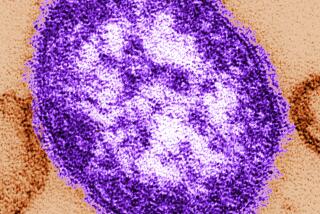7 children are infected by bacterium at L.A. hospital
- Share via
White Memorial Medical Center near downtown Los Angeles has closed its neonatal and pediatric intensive care units to new admissions after seven children became infected with a virulent bacterium, including one baby who probably died as a result, hospital officials said Friday.
The Boyle Heights hospital shut its busy neonatal unit Dec. 4 after identifying an outbreak of Pseudomonas aeruginosa, which is believed to have infected five babies.
Then Friday, White Memorial closed its high-level pediatric unit after learning that two older children were infected with the bacterium. Dr. Rosalio Lopez, the hospital’s chief medical officer, said he is unsure if the new cases are linked to the outbreak among babies.
Neither unit will be reopened until “we believe it is safe for the patients to be admitted,” Lopez said, adding that other parts of the hospital are not affected.
White Memorial officials said they believe that the most likely cause of the outbreak is improper cleaning of a laryngoscope blade, a piece of equipment used to insert breathing tubes. They are working with local, state and federal health investigators to conclusively determine the source.
Lopez said the hospital has tightened its infection control practices, notified the families of patients in the affected units and given antibiotics to all babies remaining in the neonatal unit as a precaution.
“Our first priority is to continue to work with the families affected in this situation,” Lopez said. “We’re totally committed to providing our patients safe care.”
Any critically ill babies born at the hospital now are being taken to a special isolation area to be stabilized before being transferred to other hospitals. High-risk pregnant women are also being advised to consult with their doctors to determine if they should go to White Memorial or another hospital.
About 90% of the hospital’s patients are Latino.
‘Being extremely cautious’
Los Angeles County public health officials say that their investigation is ongoing and that the number of infected patients may change as test results come in.
“They are being extremely cautious,” Dr. Laurene Mascola, chief of the county’s acute communicable disease control unit, said of the hospital.
P. aeruginosa is a common bacterium found in water and soil and can be spread through body contact, fluids and water. In most people, it is not deadly or even dangerous, because their immune systems can ward off infection.
But that is not the case in patients with weakened immune systems, such as premature babies, patients with cancer or AIDS and those on breathing machines.
In such situations, the bacterium can cause a variety of infections depending on where it enters the body. These include respiratory, urinary tract and blood infections.
It can spread rapidly and, in some cases, be unstoppable.
Babies in the neonatal unit are especially at risk for infections, because they are often connected to ventilators, tubes, monitors and other equipment that give bacteria an easy pathway to the body.
“It’s a group of patients that are very vulnerable,” said Dr. Arjun Srinivasan, a medical epidemiologist at the U.S. Centers for Disease Control and Prevention. “They’re very sick, so they are at risk of these infections. The care that’s delivered for them is very complicated.”
The bacterium is particularly deadly for extremely premature and underweight infants, said Dr. Leandro Cordero, director of the newborn intensive care unit at Ohio State University Medical Center. His hospital had an outbreak a decade ago that sickened about 10 infants, most of whom died.
Babies born before 27 weeks of gestation and weighing less than 2 pounds already have a 40% to 50% chance of dying from other causes, Cordero said. But that mortality rate can rise to 70% to 80% with a P. aeruginosa infection, he said.
Experts said doctors face a Catch-22 with these tiny patients. They can’t live without medical interventions, but such steps can increase their risks of other problems.
“Those infants have no chance at survival without all the types of invasive devices that they have,” said Dr. William Jarvis, an expert in hospital infections who previously worked at the CDC. “But those devices obviously place those patients at risk, because they are bypassing the normal body defense mechanisms.”
The bacterium is hardy and -- like the more familiar Staphylococcus aureus, or staph -- can develop resistance to common antibiotics. Experts recommend that infected patients be isolated from others and that units known to harbor the bacterium receive deep cleanings.
Since Nov. 30, 33 patients have been treated in White Memorial’s neonatal unit. Of the five babies who were infected, three died, Lopez said, but only one death appears to have been caused by the infection. Eighteen babies showed no signs of the bacterium. The remaining 10 had colonies of P. aeruginosa in their noses or rectums but no signs of infection.
Thirteen babies remain in the neonatal intensive care unit, Lopez said. The 28-bed unit is in a specialty care tower that opened in April.
Hospital officials said they are seeking outside reviews of all deaths in the neonatal unit since Nov. 30.
Other such outbreaks
Several outbreaks of P. aeruginosa have been identified previously in neonatal nurseries around the country.
From 1997 to 1998, 16 newborns died at Children’s Hospital of Oklahoma. An investigation found that the bacterium had been found under the fingernails of two nurses, although researchers said they were unsure if that was the mode of infection.
In 1997, Children’s Hospital Boston had to close its neonatal unit after four newborns died from P. aeruginosa infections.
After a 1999 P. aeruginosa outbreak in which five infants were sickened and one of them died, Prince George’s Hospital Center in Maryland hired a full-time technician just to clean equipment in the neonatal unit. It has not seen an outbreak since, said Abdul Zafar, director of infection control for the system that runs the hospital.
Mascola of L.A. County said her agency did not release information on the outbreak at White Memorial before the hospital came forward Friday, because there was no risk of harm to the general public.
“We don’t go public with any outbreak unless its something that the public needs to know about that’s going to affect their health,” she said.
According to the CDC, about 2 million patients suffer hospital-acquired infections annually, accounting for 90,000 deaths and $4.5 billion in healthcare costs.
More to Read
Sign up for Essential California
The most important California stories and recommendations in your inbox every morning.
You may occasionally receive promotional content from the Los Angeles Times.











